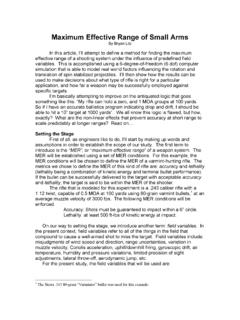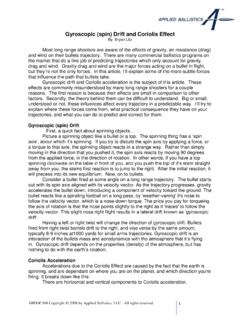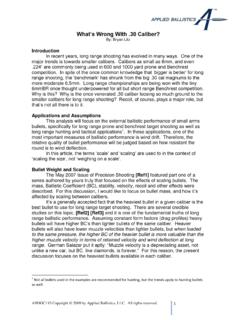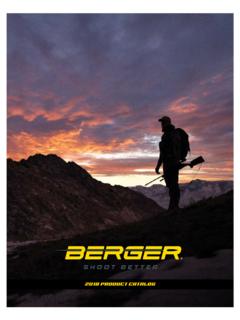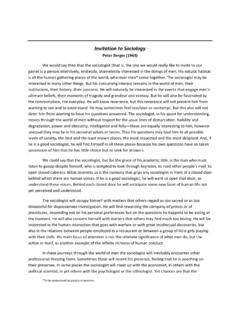Transcription of Design Berger 7mm 168 grain VLD - Applied Ballistics LLC
1 Copyright 2008 by Applied Ballistics , LLC. All rights reserved. 1 Berger s 7mm VLD Bullets Part 1: Properties and Test Results By: Bryan Litz Introduction Berger currently offers two bullets in 7mm: 168 grain and 180 grain VLD s. The versatility of these two bullets extends from big game hunting to long range benchrest competition and everything in between including long range NRA prone and F-class score shooting. The 7mm 180 grain VLD is of particular interest because of its stellar advertised BC. In part 1 of this two part series, I ll describe the ballistic properties and performance of these two bullets in a general sense, meaning the information applies to all types of shooting that these bullets might be used for.
2 In part 2, I ll explore the ballistic properties and performance of the two bullets from the perspective of long range NRA prone slow fire competition. Design Berger 7mm 168 grain VLD Dimensions taken from Lot#899 Bullet Properties Test Equipment Sample Size: 5 Velocity Range: 2900 - 1900 fps Weight: 168 grains Barrel: Broughton Ogive Radius: calibers Twist rate: 1 turn in in Rt/R: Bore/Groove: / Figure 1. Bullet dimensions, properties, and test equipment. Figures 1 and 2 show dimensioned drawings of the bullets uses for the ballistic coefficient test firing. Note the very aggressive secant ogive profile of the VLD Design .
3 This Design feature represents a compromise that many shooters know all too well. The long radius secant ogive is great for drag reduction; however the grouping potential of VLD bullets is known to be very sensitive to seating depth. When viewed side by side, it s very clear that the boat-tail and ogive of the two bullets are very similar. The only Design difference between them is the length of the bearing surface. The bearing surface of the 180 grain bullet is longer than the 168 grain bullet, and the Copyright 2008 by Applied Ballistics , LLC. All rights reserved. 2 overall length is longer. Some minor differences are apparent from the drawings.
4 For example, there is a degree difference in boat-tail angle, a difference in ogive length, a caliber difference in ogive radius, and a difference in meplat diameter. It s important to point out that the dimensions on these drawings come from my measurements of the given lot numbers. The measurements are made on a lathe with a dial indicator, and I don t claim that they re perfect. The tolerances of the dimensions is not important to the performance of the bullets, I only bring it up to clarify that my measurement of BC is tied to this particular lot number, with these dimensions. The property that s most likely to vary for different lots of bullets is the meplat diameter.
5 Near the end of the article is a table showing how you can expect the BC to vary for different meplat diameters. My test results are valid for the meplat diameter shown in the drawings, which is the nominal value for the lot tested. Berger 7mm 180 grain VLD Dimensions taken from Lot#341 Bullet Properties Test Equipment Sample Size: 17 Velocity Range: 2900 fps-1700 fps Weight: 180 grains Barrel: Broughton Ogive Radius: calibers Twist rate: 1 turn in in Rt/R: Bore/Groove: / Figure 2. Bullet dimensions, properties, and test equipment. The observation that both of these bullets have similar ogive and boat-tail designs indicates that they should have similar form factors.
6 They have different length bearing surfaces, but of all the parameters of bullet Design , the bearing surface length has the least influence on form factor. The three major components of aerodynamic drag on a bullet are: (shock) wave drag, base drag, and skin friction drag. Wave drag makes up most of the drag, and is affected by the ogive shape, including meplat diameter. Base drag is the second most important component of drag and can be reduced with a properly designed boat-tail. Skin friction drag is the least important component of drag, and is proportional to the wetted area of the bullet. The differences Copyright 2008 by Applied Ballistics , LLC.
7 All rights reserved. 3 between the two bullets that would affect the form factor the most are the meplat diameter and bearing surface length. The form factor of the longer 180 grain bullet is improved by having a smaller meplat diameter than the 168 grain bullet1, but the added length increases the wetted area and skin friction drag. The offsetting effects result in very similar form factors for the two bullets. The 180 grain VLD advertises a G1 BC of lb/in2. This bullet used to come with an advertised G1 BC of lb/in2 until a couple years ago when Berger reduced it. No Design changes were made to the bullet; it was simply an adjustment to the advertised BC.
8 How close is the new advertised G1 BC ( lb/in2) to the actual measured G1 BC? Read on. Stability Stability becomes a concern for longer than average bullets such as these 7mm VLD s. The obvious question is: what rate of twist is required to properly stabilize the bullets? Manufacturers typically provide this information on the bullet boxes. Berger recommends a 1:10 twist for the 168 grain VLD, and 1:9 twist for the 180 grain VLD. Going with the manufacturers recommended twist is a safe approach, as they tend to advertise this number conservatively. These manufacturer supplied conservative numbers might satisfy the less curious crowd of shooters, but those reading this article are probably interested in more detail.
9 To examine the stability characteristics of these bullets, we turn to Don Miller s twist rule, which has appeared in these pages for several years. Shooters are always interested in how precision is affected by stability. Is there an optimal twist rate for a particular bullet? Precision is affected by twist rate and stability, but not how you might think. I ll provide a short review of the gyroscopic stability factor (Sg) and what it means. If you re interested in more details, you can refer to some past issues of PS with articles by Don Miller [Ref1] [Ref2] [Ref3]. The measure of static bullet stability is the gyroscopic stability factor; Sg, which (in words) represents the ratio of stabilizing torque to de-stabilizing torque.
10 If the ratio is greater than , the stabilizing torque is stronger than the de-stabilizing torque, and the bullet flies point first. If the ratio is less than , the opposite is true, and the bullet tumbles. In practice, you want the Design Sg to be something greater than to leave a margin for error. Values of Sg between and are often cited as minimum Design values [Ref1] (I prefer ). If the twist rate of the barrel is adequate, the bullet will be sufficiently stabile, meaning Sg will be at least What if the twist is faster? Is it bad to have too much twist? The answer is: it can be. There are many factors that influence bullet dispersion which are related to spin rate.

